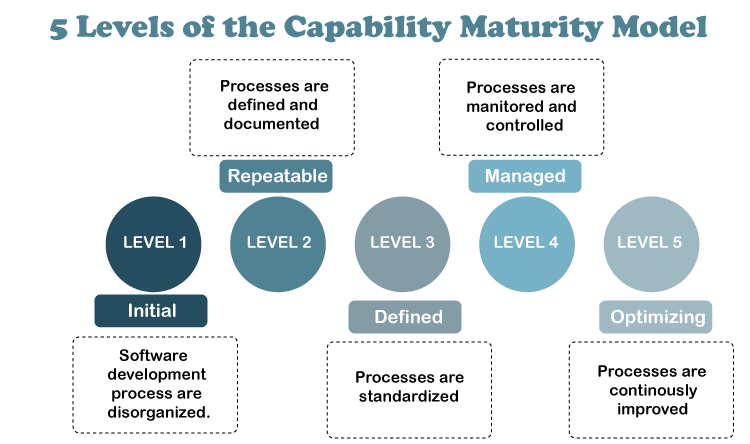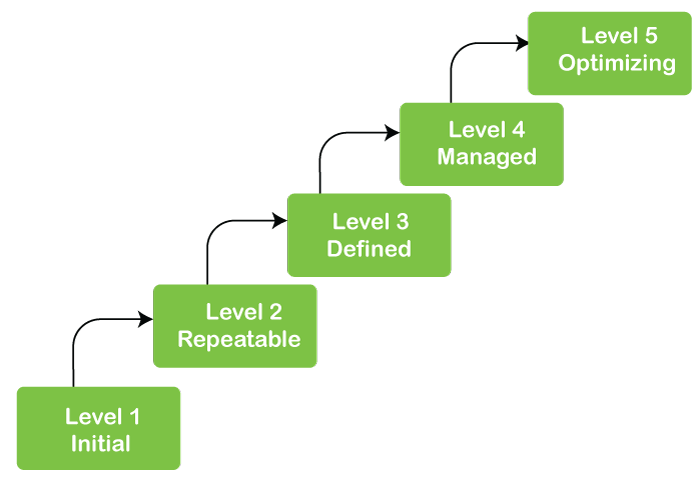What is the full form of CMMCMM: Capability Maturity ModelCMM full form as it stands now, higher education is a complicated structure that supports research, industrial interface, teaching, and learning, as well as collaboration with international standards and extensions. Also, as higher and higher education institutions apply for assessment and accreditation, it is necessary to review the gradual advancements made to the current educational system. 
Maturity models are helpful for businesses that place a focus on small-scale process changes. By enhancing a collection of processes at a specific maturity level, maturity models can help institutions in higher education assess where they are. Manford and McSporran assert that the following features and presumptions characterize maturity models: • The measurement aspect: How long did the specific task take? What was the organization's expense for the development? • A maturity matrix, which defines a number of levels or stages that signify increased capability and performance in specific organizational activities. • That procedures that are more clearly defined can result in superior products and that organizations move on to the next degree of maturity when they meet its standards. The Software Capability Maturity Model (SW-CMM) from Carnegie Mellon University is the most well-known maturity model, but there are numerous CMM-like models used in industry, including the System Engineering Capability Maturity Model (SE-CMM), Software Acquisition Capability Maturity Model (SA-CMM), System Engineering Capability Assessment Model, EIA/IS 731System Engineering Capability Model, System Security Engineering CMM, FAA Integrated CMM, IEEE/EIA 12207, These maturity models concentrate on one specific area of knowledge and ignore the rest, despite the fact that they do have certain inherent limits. For instance, SEI's CMM focuses on streamlining organizational processes but ignores employee growth. P-CMM was created by Curtis, Hefley, and Miller to improve the workforce's abilities and knowledge for such relevant staff concerns. The Personal Software Process (PSP), a third CMM-related approach that focuses on the individual software engineer, was proposed by Humphrey. This paradigm acknowledges that individual-level process improvement may and should start. The CMM is a framework that illustrates an evolutionary route of process improvement leading to an organization with greater maturity. With CMM, an organization can assess its current level of software process maturity and then set priorities for enhancement. The stage of maturity that an organization is currently in can be classified as Initial, Repeatable, Defined, Managed, or Optimizing. The Capability Maturity Model's (CMM) five levels can be summarised as follows:• Initial: Ad hoc and occasionally chaotic, the development process is described as such. Success is mostly dependent on human effort and heroism, and there are few clearly defined systems. • Replicable: To keep track of costs, schedules, and functionality, fundamental project management procedures are designed. To replicate previous accomplishments on projects with related applications, the required process discipline is in place. • Specified: The organization's management and development actions are recorded, standardized, and integrated into a family of standardized processes. • Managed: Accurate measurements of the process and product quality are gathered in order to comprehend and manage the process and product. • Optimizing: Feedback from the process and from testing cutting-edge concepts and technologies facilitates continuous process improvement. The international education sector is making attempts to use several quality frameworks, such as ISO9000 and Total Quality Management, in order to maintain educational standards (TQM). These quality frameworks must be carefully modified to meet the needs of the educational sector because they were primarily created for industrial sectors. 
Need For This Model:There are many parallels between the current state of IT, engineering, and MBA education in the nation and the software situation that ruled the world a few years ago. A few years ago, there were thousands of software firms due to the tremendous need for software. These businesses frequently conned clients by failing to deliver on promises, charging too much, providing subpar goods, etc. Many customers felt duped because they had to practically buy the service on faith because they had no visibility into their capacity to supply it. The US Department of Defense, which was the top consumer of software, established the Software Engineering Institute to control this issue (SEI). The mission of SEI was to develop the capability maturity model (CMM) so that it could be used to provide appropriate visibility into a supplier's capacity to deliver software services. Similar circumstances currently exist in India's technical and managerial education systems. Owing to the increased demand for IT, engineering, and management education, numerous private colleges have emerged; at the moment, 90% or more of the schools are private. This need is partly driven by the rise in knowledge-based sectors like the IT sector. Many of these schools and institutes are unable to give the training they advertise, but because the customers (students and parents) are unable to assess the institutions' capacity, they "purchase" the education at exorbitant costs. And in the end, they frequently feel taken advantage of and like they didn't receive their money's worth because the school offered few skills and didn't do much to aid in finding suitable employment. The worst part of this fraud is that young people lose valuable years of their lives in addition to money. It is obvious that private sector participation is necessary to meet the enormous demand. Similar to software, a capability maturity model for education is currently required. This model may be used to assess the competence of education providers and give clients proper visibility into the various facets of their capability. Such a framework can also assist colleges in targeting their improvement efforts to strengthen their capacity.
Next TopicFull Forms List
|
 For Videos Join Our Youtube Channel: Join Now
For Videos Join Our Youtube Channel: Join Now
Feedback
- Send your Feedback to [email protected]
Help Others, Please Share










